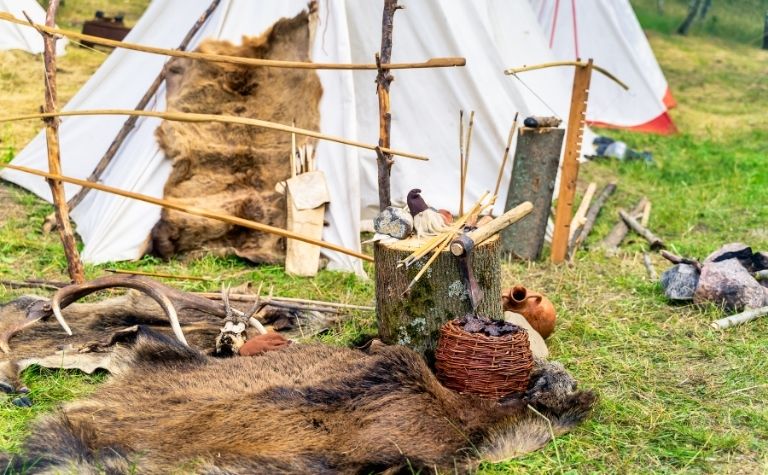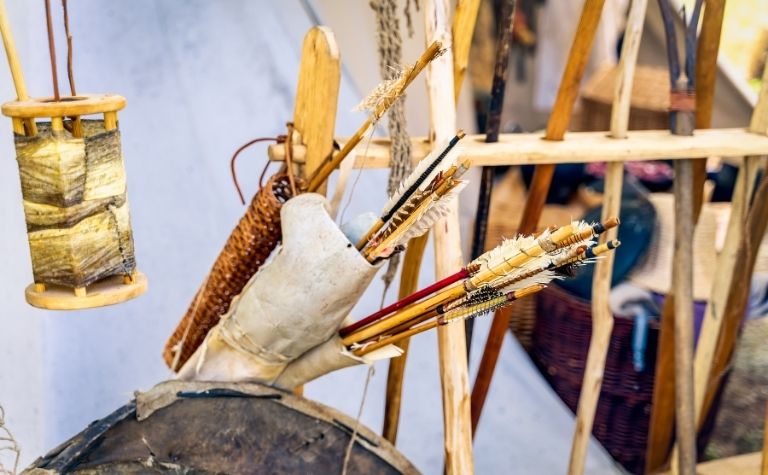The word “Viking” probably evokes images of a warrior with a battle axe or a sword and shield. But the Vikings used long-range weapons as well as melee weapons.
In addition to axes, swords, and shields, the Vikings’ combat included archery.
Vikings used longbows at the start of battles to weaken enemy defenses before charging in for melee attacks.
They also used bows and arrows to hunt animals for food.
Both the bows they used for fighting and the ones they used for hunting were usually made from yew wood.
Because bows were made of organic materials like wood and flax, few bows survived the Viking Age to the present day.
The few bows archeologists have found indicate that the Vikings used longbows for hunting and battle, and they often decorated their arrows.
Also see Dane Axes in the Viking Age to learn more.

Did Vikings Use Bows or Crossbows?
Humans have used bows in combat for millennia and even longer for hunting.
But what about crossbows, a more technically complicated weapon?
Is it possible that the Vikings used crossbows, too?
There is no archeological evidence that suggests the Vikings used crossbows, either for hunting or in combat.
Crossbows were invented sometime in the late Viking age, but it’s unlikely they made their way into Viking hands.
According to the Encyclopedia Britannica, crossbows did not appear in Europe until the 10th or 11th century. [1]
The Viking Age lasted until 1066, or the middle of the 11th century, so there is not much room for overlap between the Vikings and crossbows.
During the Viking Age, crossbows were primarily used in Asia and the Mediterranean.
There is also no physical evidence that crossbow technology made it to Scandinavia during the Viking Age.
Crossbows do not appear in Viking burial sites.
The National Museum of Denmark does not list crossbows in its catalog of Viking Age weapons.
If the Vikings used crossbows at all, there are no historical traces left to prove it. [2]
Also see Why Did the Vikings Say Skol? to learn more.
What Were Viking Bows Made Out Of?
Most of the bows used by the Vikings have decomposed in the thousand years since the Viking Age.
However, one archeological site in Germany, Hedeby (also called Haithabu), is home to several pieces of Viking Age bows.
Viking longbows were primarily made out of yew wood due to its elasticity and strength, and the strings were probably made from flax.
Additionally, there are some remnants of Viking bows made with elm.
Wood taken from a yew tree has two layers: the flexible sapwood and the dense heartwood.
Heartwood becomes the inner side of the bow, the side facing the archer, and offers strength and support.
The sapwood side faces the target and bends without breaking. The resulting bow is supple, powerful, and reliable.
One famous yew bow found at Hedeby measures about 193 centimeters (75.98 inches) long. Bows like this one are tall with a shallow curve.
It had a draw weight of nearly 45 kilograms (99.20 pounds) and a range of two hundred meters.
Again, the string was probably made from flax, though it might have been animal sinew.
The bow fragments that were made of elm found at Hedeby aren’t nearly as well-preserved as the yew bow remnants.
Also see Norsemen vs Vikings: What’s the Difference? to learn more.

What Did Viking Arrows Look Like?
Most of the archeological evidence of Viking arrows comes in the form of arrowheads.
Hundreds of Viking Age arrowheads litter battlegrounds all over Northern Europe, from the British Isles to Scandinavia to Germany.
The shapes of these arrowheads vary depending on their function and type.
Viking combat arrows were made with pine shafts and iron arrowheads. Some arrowheads were barbed; others were sharpened to a point.
Arrows for hunting were sometimes blunt so as not to damage the target’s hide, and sometimes the ends were decorated with feathers.
Most Viking arrows were pine, though some were birch, depending on what trees were more prevalent where the maker lived.
As with bows, wooden arrow shafts did not survive to the present day and are relatively rare.
The Vikings did not have a uniform thickness or length of arrow shafts, as the size and shape vary from one arrow to another.
Arrowheads came in several shapes. Some were traditional, triangular blades that could cut through enemy armor and flesh.
Some were wrapped with flammable materials, allowing archers to rain fire on enemy forces.
Others had less conventional shapes. Archeologists have found a spiral-shaped arrowhead and others with barbs on the sides.
Some Viking hunting arrows were made entirely of wood.
These arrows had a blunt, club-shaped head so that the Vikings could kill their prey without shedding blood.
Another discovery from Hedeby, these arrows allowed the Vikings to hunt while still preserving the animal’s hide or feathers.
Viking arrows were fletched with three feathers on the end of the shaft. Fletching helped the arrows to continue traveling in the intended direction.
It is unknown what kinds of birds or colors of feathers the Vikings preferred to use when fletching their arrows.
The Vikings liked to decorate their arrows, as they decorated most of their weapons.
They attached small iron fittings to some of their arrows, but only the ones used for hunting.
Hunters were more likely to retrieve their arrows than combat archers, so they did not waste decorations on combat arrows.
Did the Vikings Practice Archery?
The Vikings used bows for more than just hunting.
Vikings began their battles with their archers, thinning out the enemy from afar and driving their opponents inward.
After the archers accomplished their work, the Vikings moved forward with swords, axes, and spears.
The Vikings practiced archery; in fact, it was an important part of their battle strategy. It proved to be successful, judging by the number of battles they won.
Archeologists have discovered fortresses and other buildings with Viking arrowheads embedded in the walls and near the gates.
This suggests that the Vikings drove their enemies back with archery before invading on foot.
Historical accounts also support the Vikings’ use of archery. Records tell of arrows that could split shields, pierce armor, and penetrate helmets.
Sometimes, during siege warfare or in a naval battle, archers use flaming arrows to destroy enemy property.
The Viking Sagas depict kings and peasants alike using bows, demonstrating the popularity of the weapon.
Conclusion
The Vikings may not be as famous for archery as swordplay, but bows were critical to Viking warfare. The arrowheads all over Europe are proof.
